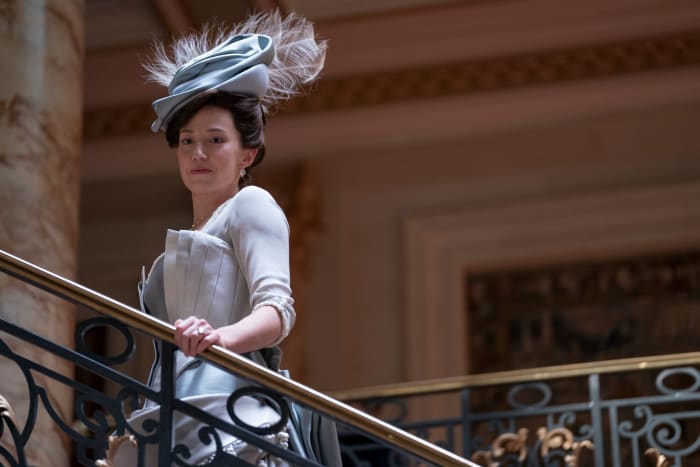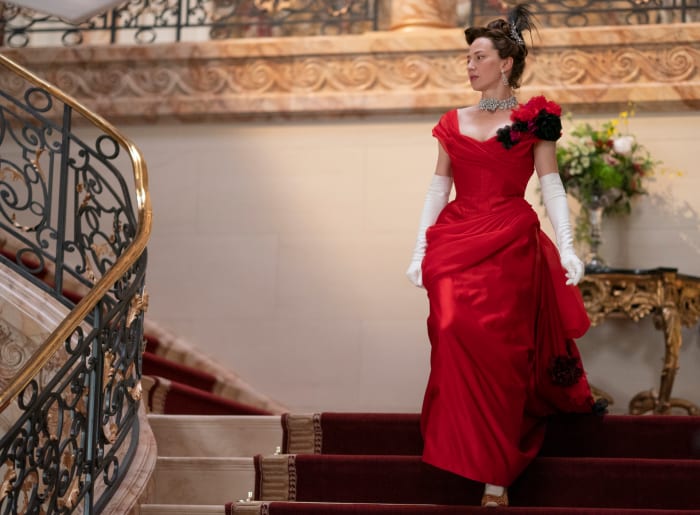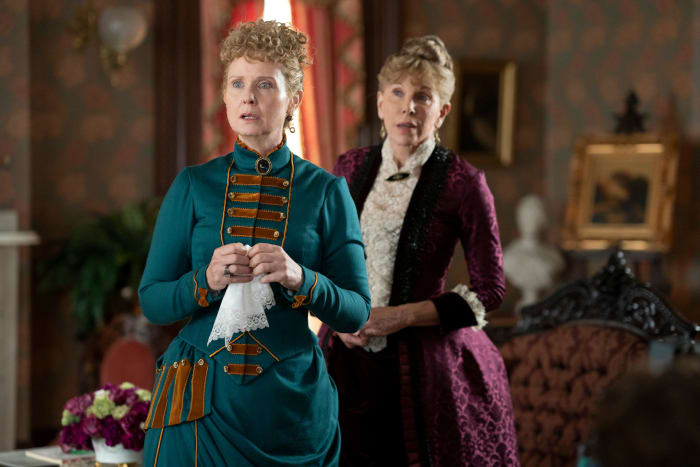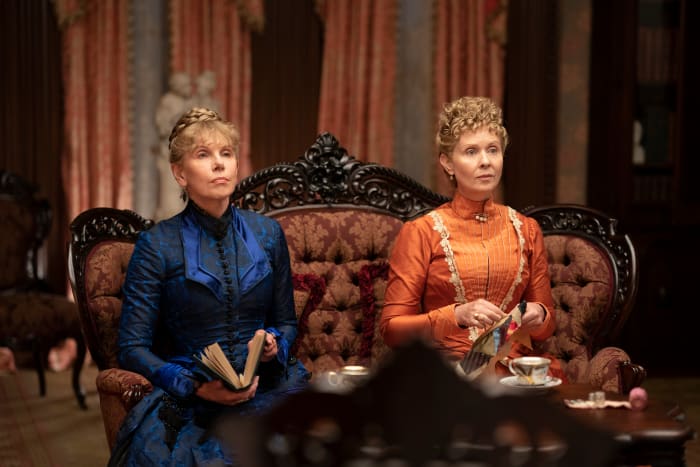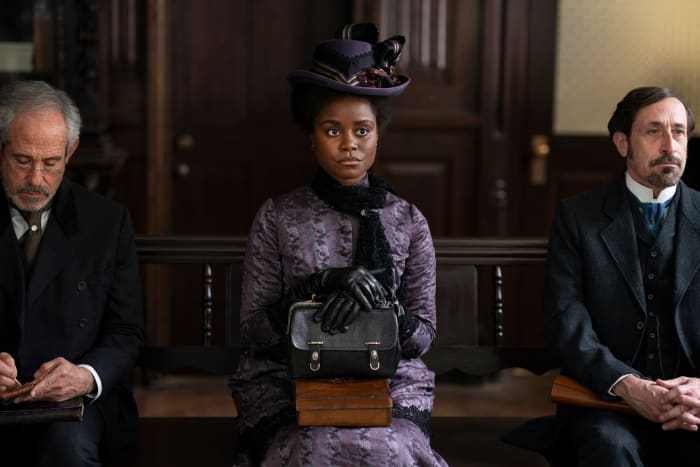Like society season, “The Gilded Age” the long-gestating, sweeping and, of course, soapy period series by “Downton Abbey” creator Julian Fellowes is now in full-swing. But in this round, the examination of socio-economic and class hierarchy focuses on a distinctly American clash of old and new money in New York City’s post-industrial boom. Or, more specifically, the tony corner of Fifth Avenue and 61st Street (via the actual set in Troy, New York), where Robber Baron Dynasties are muscling their way into the Old Guard Establishment in 1882, as younger generations begin challenging stuffy, traditional mindsets, because maybe leisure class women actually want to have a career. (Cue a perplexed Dowager Countess, across the pond, asking, “What is a ‘weekend‘?”)
Fittingly, the 10-episode series on HBO Max looks exceedingly grand, from the sprawling sets to the expansive cast of characters (who have like 8,000 Tony Awards amongst them all) to the spectacular costumes by Kasia Walicka-Maimone (“The Goldfinch,” “Moonrise Kingdom.”)
“It’s a very collaborative piece that works in a tight, tight communication with, first of all, Julian Fellowes and his material, the directors [Michael Engler, Salli Richardson-Whitfield], the production designer [Bob Shaw], directors of photography [Vanja Cernjul, Manuel Billeter] who portray our work,” she says. “Then it comes out with what you end up seeing on the screen.”
Filming over the pandemic in a bubble, Walicka-Maimone and her team worked with “exquisite makers” from the U.S. and Europe to custom-design upwards of 5,000 costumes for the entire season.
Faithful to the characters portrayed, no details were spared in the head-to-toe costume design, from foundation garments to luxurious trims on the breathtaking gowns even to the day dresses and Bertha Russell (Carrie Coon)’s seemingly infinite collection of imposing hats (above). The entire series could also be a study on the evolution of the bustle from 1880 to 1889: A glance through a roomful of society’s finest reveals varying stages, from the avant-garde fashion-forward volume (like on the invading Russells) to the old timers maintaining more minimal princess line silhouettes.
“We did faithful research of that period, and studied in detail the American fashions of 10, 15 years before 1882 and fashion that followed 1882,” Walicka-Maimone says, noting how, in the 1880s, women’s fashion underwent relatively rapid changes (well, for the non-Internet or even radio/TV era), also influenced by artistic movements of the time. “We tried to represent what was happening on the street at that time, and in the rooms the society as portrayed.”
To help identify and distinguish each of the families and characters, she assigned color palettes inspired by nature, whether countryside florals, verdant parkland or majestic birds: “It’s very, very deeply steeped in an endless amount of historical material, and then it’s a bit embellished, as any film material needs to do for for the sake of storytelling.”
Ahead, the costume designer breaks down the inspirations and references behind the key character looks.
New ‘Grand Dame’ Bertha Russell
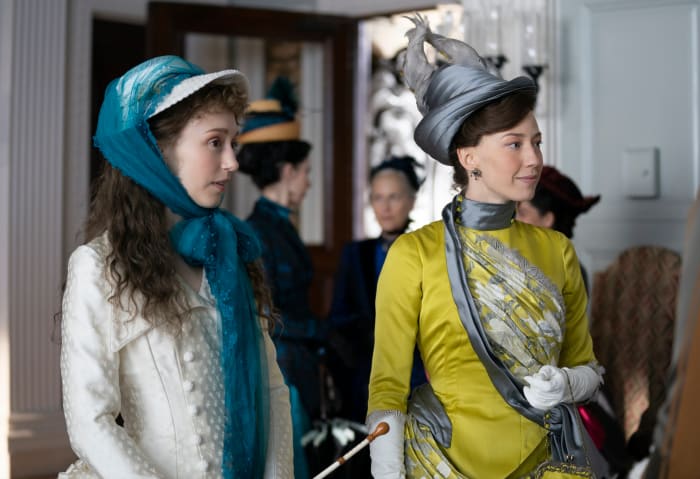
Gladys (Taissa Farmiga) attends a charity meeting with mom Bertha.
Photo: Alison Cohen Rosa/Courtesy of HBO
“It’s too much?,” asks a usually unflappable but momentarily panicked Bertha, readying for a charity meeting full of high society arbiters.
Turner (Kelly Curran), the lady’s maid who was plucked from an old establishment household, suggests Bertha forgo the excessive brooch on her already-opulently-draped, lace-trimmed, acid yellow and gunmetal day dress, complete with a towering twisted-feather, double-horn-like hat (above). But is anything really too much for Fifth Avenue’s new matriarch?
“Bertha is the new force who shows up in the Gilded Age and pioneers French fashion on the streets of New York and in the society of New York,” says Walicka-Maimone. “It’s a very exciting time when European fashions are being embraced and acknowledged, and are bringing a certain level of excitement and newness to the streets.”
The Russell ladies are on the forefront of the more prominent, structured bustles, with more elaborate draping, layering and accoutrements which reached the pinnacle of volume and proportion in the mid-1880s.
“Bertha’s like the giant breath of fresh air who’s trying to outdo the establishment, but she still wants to belong to the society,” says Walicka-Maimone. She expressed Bertha’s haute couture-loving (and haute monde-disrupting) character through fanciful trims, crisp pleats, sculptural molding and exaggerated ruffs on scooped necklines all period-authentic, although Walicka-Maimone admits to enjoying some creative license with the look-at-me-now colors and profusion of textures and embellishments.
While seeming like subliminal messaging of her complex nature (at heart, she just wants to be accepted by the group!), Bertha’s consistent theme of asymmetry is actually just en vogue, à la the Gilded Age. “That period was very experimental in the draping, use of color and shapes of garments and hats,” says Walicka-Maimone. “During [the 1880s], a lot of asymmetry appeared, with very free organic draping. There’s a very interesting use of mixed and unexpected elements in embellishment of the dresses.”
As one-half of the Russell power couple, Bertha exercises her strategic negotiation skills and steely business acumen, which feels very relatable (like her cutting edge fashion sense) to the modern viewer.
“We recognize elements because designers in the ’30s, ’50s, ’70s, ’90s and 2000s keep drawing from that period,” says Walicka-Maimone.
Old Guard Establishment Agnes and Ada
Across 61st Street from the Russells preside dowager Agnes van Rhijn (Christine Baranski), of Pennsylvania Dutch-American aristocracy, and her unmarried younger sister Ada Brook (Cynthia Nixon, giving some serious HBO Max whiplash). While Ada’s countenance is sweeter and gentler, she, like her formidable sibling, remain resistant to the brash new guard shaking up polite New York City society and they dress the part.
“I always said, ‘You need to feel like you’re walking through the grandest room of Metropolitan Museum of Art’ [with their costumes] you’re equally in awe of that world, as we are of the world of Bertha,” says Walicka-Maimone. “There’s no value to which one is better. They’re just slightly different.”
While Bertha luxuriates in her subversively Stanford White-designed extravagant interiors, Agnes and Ada reign in darker, urbane hues and plush furnishings. Similarly, in contrast to their new neighbor’s flashy mix of vibrant colors and shiny metallics, Agnes sticks to sumptuously subtle jewel tones.
“We knew that Ada would have the oranges, browns and greens as somebody who’s like a librarian and missionary on a journey to discover charities and be part of the society,” says Walicka-Maimone, who looked to real members of society for reference, as well as to works of art from the period. The sisters’ textures and details are just as premium as Bertha’s: lush velvets, magnificent brocades, ornate buttons, delicately ruffled lace and immaculately tailored walking suits.
Boundary-Breaking Journalist Peggy
After a chance meeting with Agnes’s and Ada’s broke (and not very street smart) niece Marian (Louisa Jacob) at Pennsylvania train station, recent graduate Peggy Benton (Denée Benton) takes on a job as the elder sister’s secretary. Due to a rift with her affluent parents living in Brooklyn, Peggy moves in with her new boss to pursue her professional dreams. She seeks to break racial and gender barriers and prove to herself and her skeptical business-owner father Arthur (John Douglas Thompson) that a Black woman can become a successful writer.
Walicka-Maimone once again dove into historical research and photographs of the burgeoning African-American middle class in the late 19th century to depict Peggy’s wardrobe journey into the professional world dominated by white men, focusing on “blacks, silvers and gorgeous combinations of oranges and browns” for her color palette.


